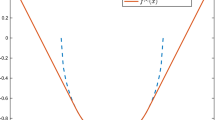Abstract
This paper provides efficient and easy to implement formulations for two problems in structural optimization as second-order cone programming (SOCP) problems based on the minimum compliance method and derived using the principle of complementary energy. In truss optimization both single and multiple loads (where we optimize the worst-case compliance) are considered. By using a heuristic which is based on the SOCP duality we can consider a simple ground structure and add only the members which improve the compliance of the structure. It is also shown that thickness optimization is a problem similar to truss optimization. Examples are given to illustrate the method developed in this paper.
Similar content being viewed by others
References
Achtziger W (1996) Truss topology optimization including bar properties different for tension and compression. Struct Multidiscipl Optim 12:63–74
Achtziger W (2007) On simultaneous optimization of truss geometry and topology. Struct Multidiscipl Optim 33:285–304
Andersen E, Roos C, Terlaky T (2003) On implementing a primal-dual interior-point method for conic quadratic optimization. Math Program Series B 95:249–277
Beckers M (1999) Topology optimization using a dual method with discrete variables. Struct Optim 17:14–24
Ben-Tal A, Bendsøe M (1993) A new method for optimal truss design topology design. SIAM J Optim 3:322–358
Ben-Tal A, Nemirovski A (1997) Robust truss topology design via semidefinite programming. SIAM J Optim 7:991–1016
Ben-Tal A, Nemirovski A (2001) Lectures on modern convex optimization. MPS-SIAM series on optimization. SIAM, Philadelphia
Bendsøe M (1995) Optimization of structural topology, shape and material. Springer, Berlin
Bendsøe M, Kikuchi N (1988) Generating optimal topologies in structural design using a homogenization method. Comput Methods Appl Mech Eng 71:197–224
Bendsøe M, Ben-Tal A, Zowe J (1994) Optimization methods for truss geometry and topology design. Struct Optim 7:141–159
Chen YM, Bhaskar A, Keane A (2002) A parallel nodal-based evolutionary structural optimization algorithm. Struct Multidiscipl Optim 23:241–251
CIMNE (2007) GiD Version 8.0. Reference manual
Dorn W, Gomory R, Greenberg H (1964) Automatic design of optimal structures. J Mech 3:25–52
Gilbert M, Tyas A (2003) Layout optimization of large-scale pin jointed frames. Eng Comput 20:1044–1064
Hagishita T, Ohsaki M (2009) Topology optimization of trusses by growing ground structure method. Struct Multidiscipl Optim 37:377–393
Jarre F, Koc̆vara M, Zowe J (1998) Optimal truss design by interior point methods. SIAM J Optim 8:1084–1117
Kirsch U (1989) Optimal topologies of truss structures. Comput Methods Appl Mech Eng 72:15–28
Koc̆vara M, Outrata J (2006) Effective reformulations of the truss topology design problem. Optim Eng 7:201–219
Koc̆vara M, Stingl M (2003) Pennon a code for convex nonlinear and semidefinite programming. Optim Methods Softw 18:317–333
Lam Y, Manickarajah D, Bertolini A (2000) Effective reformulations of the truss topology design problem. Finite Elem Anal Des 34:159–174
Lobo M, Vandenberghe L, Boyd S, Lebret H (1998) Applications of second-order cone programming. Linear Algebra Appl 284:193–228
Makrodimopoulos A, Bhaskar A, Keane A (2008) A formulation for large-scale truss optimization. In: CD-ROM proceedings of the 6th GRACM international congress on computational mechanics, Thessaloniki, 19–21 June 2008
Martinez P, Marti P, Querin O (2007) Growth method for size, topology, and geometry optimization of truss structures. Struct Multidiscipl Optim 33:13–26
Michell A (1904) The limits of economy of material in frame-structures. Philos Mag 8:589–597
MOSEK ApS (2007) The MOSEK optimization tools manual. Version 5.0, Revision 60
Qing L, GP GS, Xie Y (2001) Evolutionary thickness design with stiffness maximization and stress minimization criteria. Int J Numer Methods Eng 52:979–995
Rozvany G (2001) Stress ratio and compliance based methods in topology optimization—a critical review. Struct Multidiscipl Optim 21:109–119
Rozvany G, Zhou M (1991) The COC algorithm, Part I: cross-section optimization or sizing. Comput Methods Appl Mech Eng 89:281–308
Sturm J (1999) Using sedumi 1.02, a matlab toolbox for optimization over symmetric cones. Optim Methods Softw 11–12:625–653
Tütüncü R, Toh K, Todd M (2003) Solving semidefinite-quadratic-linear programs using SDPT3. Math Program 95:189–217
Xie Y, Steven G (1997) Evolutionary structural optimization. Springer, Berlin
Zhou M, Rozvany G (1991) The COC algorithm, Part II: topological, geometrical and generalized shape optimization. Comput Methods Appl Mech Eng 89:309–336
Zhou M, Rozvany G (1996) An improved approximation technique for the dcoc method of sizing optimization. Comput Struct 60:763–769
Author information
Authors and Affiliations
Corresponding author
Additional information
EPSRC grant EP/E004547/1).
Early stages of the developments of this paper are provided in the recent conference paper of Makrodimopoulos et al. (2008).
Rights and permissions
About this article
Cite this article
Makrodimopoulos, A., Bhaskar, A. & Keane, A.J. Second-order cone programming formulations for a class of problems in structural optimization. Struct Multidisc Optim 40, 365–380 (2010). https://doi.org/10.1007/s00158-009-0376-2
Received:
Revised:
Accepted:
Published:
Issue Date:
DOI: https://doi.org/10.1007/s00158-009-0376-2




